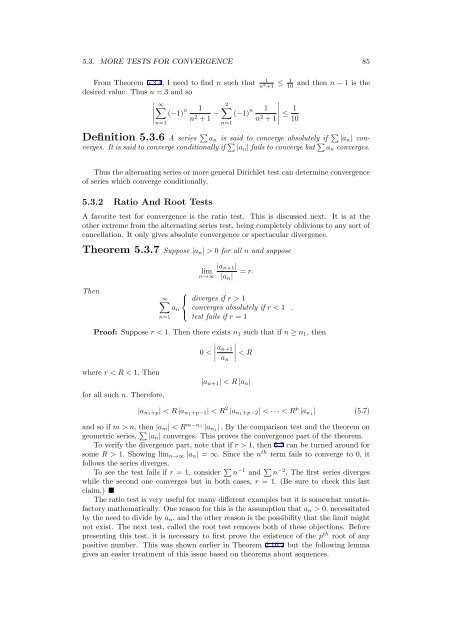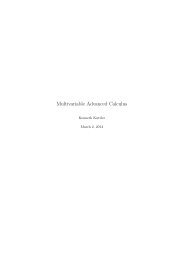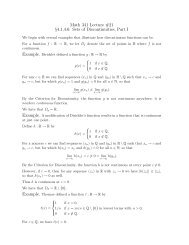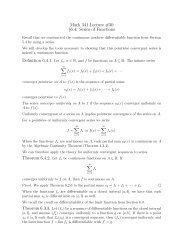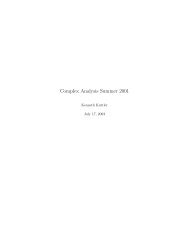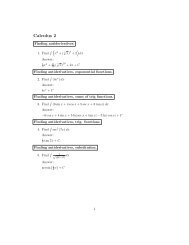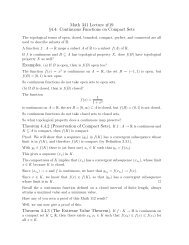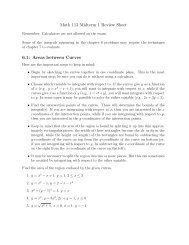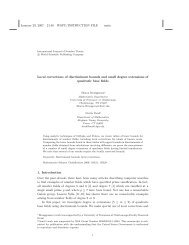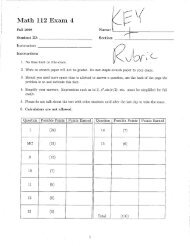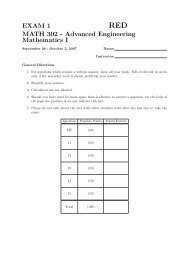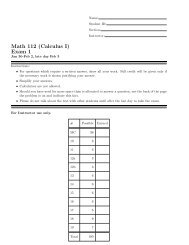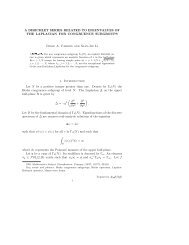- Page 1:
One Variable Advanced CalculusKenne
- Page 4 and 5:
4 CONTENTS5 Infinite Series Of Numb
- Page 6 and 7:
6 CONTENTS
- Page 8 and 9:
8 CHAPTER 1. INTRODUCTION
- Page 10 and 11:
10 CHAPTER 2. THE REAL AND COMPLEX
- Page 12 and 13:
12 CHAPTER 2. THE REAL AND COMPLEX
- Page 14 and 15:
14 CHAPTER 2. THE REAL AND COMPLEX
- Page 16 and 17:
16 CHAPTER 2. THE REAL AND COMPLEX
- Page 18 and 19:
18 CHAPTER 2. THE REAL AND COMPLEX
- Page 20 and 21:
20 CHAPTER 2. THE REAL AND COMPLEX
- Page 22 and 23:
22 CHAPTER 2. THE REAL AND COMPLEX
- Page 24 and 25:
24 CHAPTER 2. THE REAL AND COMPLEX
- Page 26 and 27:
26 CHAPTER 2. THE REAL AND COMPLEX
- Page 28 and 29:
28 CHAPTER 2. THE REAL AND COMPLEX
- Page 30 and 31:
30 CHAPTER 2. THE REAL AND COMPLEX
- Page 32 and 33:
32 CHAPTER 2. THE REAL AND COMPLEX
- Page 34 and 35: 34 CHAPTER 2. THE REAL AND COMPLEX
- Page 36 and 37: 36 CHAPTER 3. SET THEORYthere is no
- Page 38 and 39: 38 CHAPTER 3. SET THEORYIt is proba
- Page 40 and 41: 40 CHAPTER 3. SET THEORYFollow a pa
- Page 42 and 43: 42 CHAPTER 3. SET THEORY8. Show the
- Page 44 and 45: 44 CHAPTER 4. FUNCTIONS AND SEQUENC
- Page 46 and 47: 46 CHAPTER 4. FUNCTIONS AND SEQUENC
- Page 48 and 49: 48 CHAPTER 4. FUNCTIONS AND SEQUENC
- Page 50 and 51: 50 CHAPTER 4. FUNCTIONS AND SEQUENC
- Page 52 and 53: 52 CHAPTER 4. FUNCTIONS AND SEQUENC
- Page 54 and 55: 54 CHAPTER 4. FUNCTIONS AND SEQUENC
- Page 56 and 57: 56 CHAPTER 4. FUNCTIONS AND SEQUENC
- Page 58 and 59: 58 CHAPTER 4. FUNCTIONS AND SEQUENC
- Page 60 and 61: 60 CHAPTER 4. FUNCTIONS AND SEQUENC
- Page 62 and 63: 62 CHAPTER 4. FUNCTIONS AND SEQUENC
- Page 64 and 65: 64 CHAPTER 4. FUNCTIONS AND SEQUENC
- Page 66 and 67: 66 CHAPTER 4. FUNCTIONS AND SEQUENC
- Page 68 and 69: 68 CHAPTER 4. FUNCTIONS AND SEQUENC
- Page 70 and 71: 70 CHAPTER 4. FUNCTIONS AND SEQUENC
- Page 72 and 73: 72 CHAPTER 4. FUNCTIONS AND SEQUENC
- Page 74 and 75: 74 CHAPTER 4. FUNCTIONS AND SEQUENC
- Page 76 and 77: 76 CHAPTER 5. INFINITE SERIES OF NU
- Page 78 and 79: 78 CHAPTER 5. INFINITE SERIES OF NU
- Page 80 and 81: 80 CHAPTER 5. INFINITE SERIES OF NU
- Page 82 and 83: 82 CHAPTER 5. INFINITE SERIES OF NU
- Page 86 and 87: 86 CHAPTER 5. INFINITE SERIES OF NU
- Page 88 and 89: 88 CHAPTER 5. INFINITE SERIES OF NU
- Page 90 and 91: 90 CHAPTER 5. INFINITE SERIES OF NU
- Page 92 and 93: 92 CHAPTER 5. INFINITE SERIES OF NU
- Page 94 and 95: 94 CHAPTER 5. INFINITE SERIES OF NU
- Page 96 and 97: 96 CHAPTER 6. CONTINUOUS FUNCTIONST
- Page 98 and 99: 98 CHAPTER 6. CONTINUOUS FUNCTIONSF
- Page 100 and 101: 100 CHAPTER 6. CONTINUOUS FUNCTIONS
- Page 102 and 103: 102 CHAPTER 6. CONTINUOUS FUNCTIONS
- Page 104 and 105: 104 CHAPTER 6. CONTINUOUS FUNCTIONS
- Page 106 and 107: 106 CHAPTER 6. CONTINUOUS FUNCTIONS
- Page 108 and 109: 108 CHAPTER 6. CONTINUOUS FUNCTIONS
- Page 110 and 111: 110 CHAPTER 6. CONTINUOUS FUNCTIONS
- Page 112 and 113: 112 CHAPTER 6. CONTINUOUS FUNCTIONS
- Page 114 and 115: 114 CHAPTER 6. CONTINUOUS FUNCTIONS
- Page 116 and 117: 116 CHAPTER 6. CONTINUOUS FUNCTIONS
- Page 118 and 119: 118 CHAPTER 6. CONTINUOUS FUNCTIONS
- Page 120 and 121: 120 CHAPTER 6. CONTINUOUS FUNCTIONS
- Page 122 and 123: 122 CHAPTER 6. CONTINUOUS FUNCTIONS
- Page 124 and 125: 124 CHAPTER 6. CONTINUOUS FUNCTIONS
- Page 126 and 127: 126 CHAPTER 7. THE DERIVATIVEif for
- Page 128 and 129: 128 CHAPTER 7. THE DERIVATIVEThe pr
- Page 130 and 131: 130 CHAPTER 7. THE DERIVATIVE7.2 Ex
- Page 132 and 133: 132 CHAPTER 7. THE DERIVATIVEIn oth
- Page 134 and 135:
134 CHAPTER 7. THE DERIVATIVEProof:
- Page 136 and 137:
136 CHAPTER 7. THE DERIVATIVEHere t
- Page 138 and 139:
138 CHAPTER 7. THE DERIVATIVE7.5 Fi
- Page 140 and 141:
140 CHAPTER 7. THE DERIVATIVEetc. A
- Page 142 and 143:
142 CHAPTER 7. THE DERIVATIVE6. Let
- Page 144 and 145:
144 CHAPTER 7. THE DERIVATIVEThe be
- Page 146 and 147:
146 CHAPTER 7. THE DERIVATIVE7.9 Ex
- Page 148 and 149:
148 CHAPTER 7. THE DERIVATIVETheore
- Page 150 and 151:
150 CHAPTER 7. THE DERIVATIVEProof:
- Page 152 and 153:
152 CHAPTER 7. THE DERIVATIVEThen f
- Page 154 and 155:
154 CHAPTER 8. POWER SERIESThus0
- Page 156 and 157:
156 CHAPTER 8. POWER SERIESThen for
- Page 158 and 159:
158 CHAPTER 8. POWER SERIESObservat
- Page 160 and 161:
160 CHAPTER 8. POWER SERIESfor some
- Page 162 and 163:
162 CHAPTER 8. POWER SERIES2. exp i
- Page 164 and 165:
164 CHAPTER 8. POWER SERIES2. log b
- Page 166 and 167:
166 CHAPTER 8. POWER SERIESThere is
- Page 168 and 169:
168 CHAPTER 8. POWER SERIES16. Usin
- Page 170 and 171:
170 CHAPTER 8. POWER SERIESThe cond
- Page 172 and 173:
172 CHAPTER 8. POWER SERIESCorollar
- Page 174 and 175:
174 CHAPTER 8. POWER SERIES(i) lim
- Page 176 and 177:
176 CHAPTER 8. POWER SERIESProof: B
- Page 178 and 179:
178 CHAPTER 8. POWER SERIES11. Use
- Page 180 and 181:
180 CHAPTER 8. POWER SERIESdone by
- Page 182 and 183:
182 CHAPTER 8. POWER SERIESProof:It
- Page 184 and 185:
184 CHAPTER 8. POWER SERIESLemma 8.
- Page 186 and 187:
186 CHAPTER 8. POWER SERIES
- Page 188 and 189:
188 CHAPTER 9. THE RIEMANN AND RIEM
- Page 190 and 191:
190 CHAPTER 9. THE RIEMANN AND RIEM
- Page 192 and 193:
192 CHAPTER 9. THE RIEMANN AND RIEM
- Page 194 and 195:
194 CHAPTER 9. THE RIEMANN AND RIEM
- Page 196 and 197:
196 CHAPTER 9. THE RIEMANN AND RIEM
- Page 198 and 199:
198 CHAPTER 9. THE RIEMANN AND RIEM
- Page 200 and 201:
200 CHAPTER 9. THE RIEMANN AND RIEM
- Page 202 and 203:
202 CHAPTER 9. THE RIEMANN AND RIEM
- Page 204 and 205:
204 CHAPTER 9. THE RIEMANN AND RIEM
- Page 206 and 207:
206 CHAPTER 9. THE RIEMANN AND RIEM
- Page 208 and 209:
208 CHAPTER 9. THE RIEMANN AND RIEM
- Page 210 and 211:
210 CHAPTER 9. THE RIEMANN AND RIEM
- Page 212 and 213:
212 CHAPTER 9. THE RIEMANN AND RIEM
- Page 214 and 215:
214 CHAPTER 9. THE RIEMANN AND RIEM
- Page 216 and 217:
216 CHAPTER 9. THE RIEMANN AND RIEM
- Page 218 and 219:
218 CHAPTER 9. THE RIEMANN AND RIEM
- Page 220 and 221:
220 CHAPTER 9. THE RIEMANN AND RIEM
- Page 222 and 223:
222 CHAPTER 9. THE RIEMANN AND RIEM
- Page 224 and 225:
224 CHAPTER 9. THE RIEMANN AND RIEM
- Page 226 and 227:
226 CHAPTER 9. THE RIEMANN AND RIEM
- Page 228 and 229:
228 CHAPTER 9. THE RIEMANN AND RIEM
- Page 230 and 231:
230 CHAPTER 9. THE RIEMANN AND RIEM
- Page 232 and 233:
232 CHAPTER 9. THE RIEMANN AND RIEM
- Page 234 and 235:
234 CHAPTER 10. FOURIER SERIESObvio
- Page 236 and 237:
236 CHAPTER 10. FOURIER SERIESThe f
- Page 238 and 239:
238 CHAPTER 10. FOURIER SERIESThen
- Page 240 and 241:
240 CHAPTER 10. FOURIER SERIESThere
- Page 242 and 243:
242 CHAPTER 10. FOURIER SERIESNote
- Page 244 and 245:
244 CHAPTER 10. FOURIER SERIESNowwh
- Page 246 and 247:
246 CHAPTER 10. FOURIER SERIESTheor
- Page 248 and 249:
248 CHAPTER 10. FOURIER SERIESBreak
- Page 250 and 251:
250 CHAPTER 10. FOURIER SERIESThe l
- Page 252 and 253:
252 CHAPTER 10. FOURIER SERIES=∫
- Page 254 and 255:
254 CHAPTER 10. FOURIER SERIES10.7
- Page 256 and 257:
256 CHAPTER 10. FOURIER SERIESTo do
- Page 258 and 259:
258 CHAPTER 10. FOURIER SERIES18. S
- Page 260 and 261:
260 CHAPTER 10. FOURIER SERIESConcl
- Page 262 and 263:
262 CHAPTER 11. THE GENERALIZED RIE
- Page 264 and 265:
264 CHAPTER 11. THE GENERALIZED RIE
- Page 266 and 267:
266 CHAPTER 11. THE GENERALIZED RIE
- Page 268 and 269:
268 CHAPTER 11. THE GENERALIZED RIE
- Page 270 and 271:
270 CHAPTER 11. THE GENERALIZED RIE
- Page 272 and 273:
272 CHAPTER 11. THE GENERALIZED RIE
- Page 274 and 275:
274 CHAPTER 11. THE GENERALIZED RIE
- Page 276 and 277:
276 APPENDIX A. CONSTRUCTION OF REA
- Page 278 and 279:
278 APPENDIX A. CONSTRUCTION OF REA
- Page 280 and 281:
280 APPENDIX A. CONSTRUCTION OF REA
- Page 282 and 283:
282 BIBLIOGRAPHY[21] Horn R. and Jo
- Page 284 and 285:
284 INDEXintermediate value theorem
- Page 286 and 287:
286 INDEXmonotone decreasing, 63mon


